Pacemaker implantation
A pacemaker is a small device that helps control your heart rate by preventing the heart from beating too slowly. It is placed in the chest during surgery. Wires called leads are put into the heart. The device with the battery is placed under your skin, below your shoulder.

During the implantation
You will be advised not to eat or drink anything about 3 hours before the pacemaker procedure. An IV (intravenous line) is put in a vein in your arm. Medicines to make you sleepy can be given through the IV to make you more comfortable. An intravenous antibiotic is also given to reduce the risk of infection. Your chest is cleaned, and the skin is numbed. The wire leads are put into a vein and guided into your heart using an x-ray. The other end of each wire is then connected to the pacemaker. The pacemaker is placed in a small space under your skin. The incisions are closed with stitches under the skin that will dissolve. A waterproof dressing is placed on the wound site.
After the implantation
You were be monitored in the normal ward overnight and discharged the next day. Painkillers and oral antibiotics may be given for a duration of 3 days. Information about the pacemaker and general advice will be provided. Although the dressing is waterproof, you will be advised not to wet the pacemaker site. You can use your arms normally except lifting the arm above your head for about 4 weeks. You will be seen in clinic for a wound check about 5 days after discharge. Contact the doctor if you develop a fever, redness or swelling around the wound site, or if you have dizziness.
